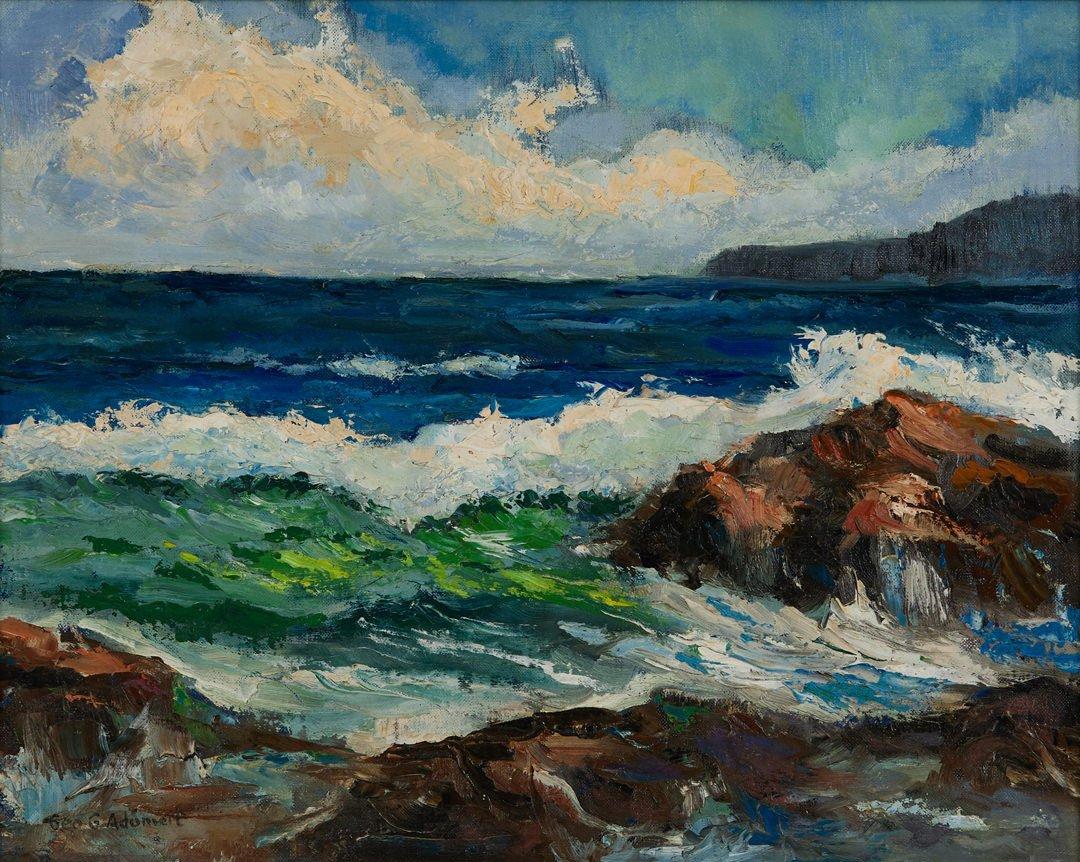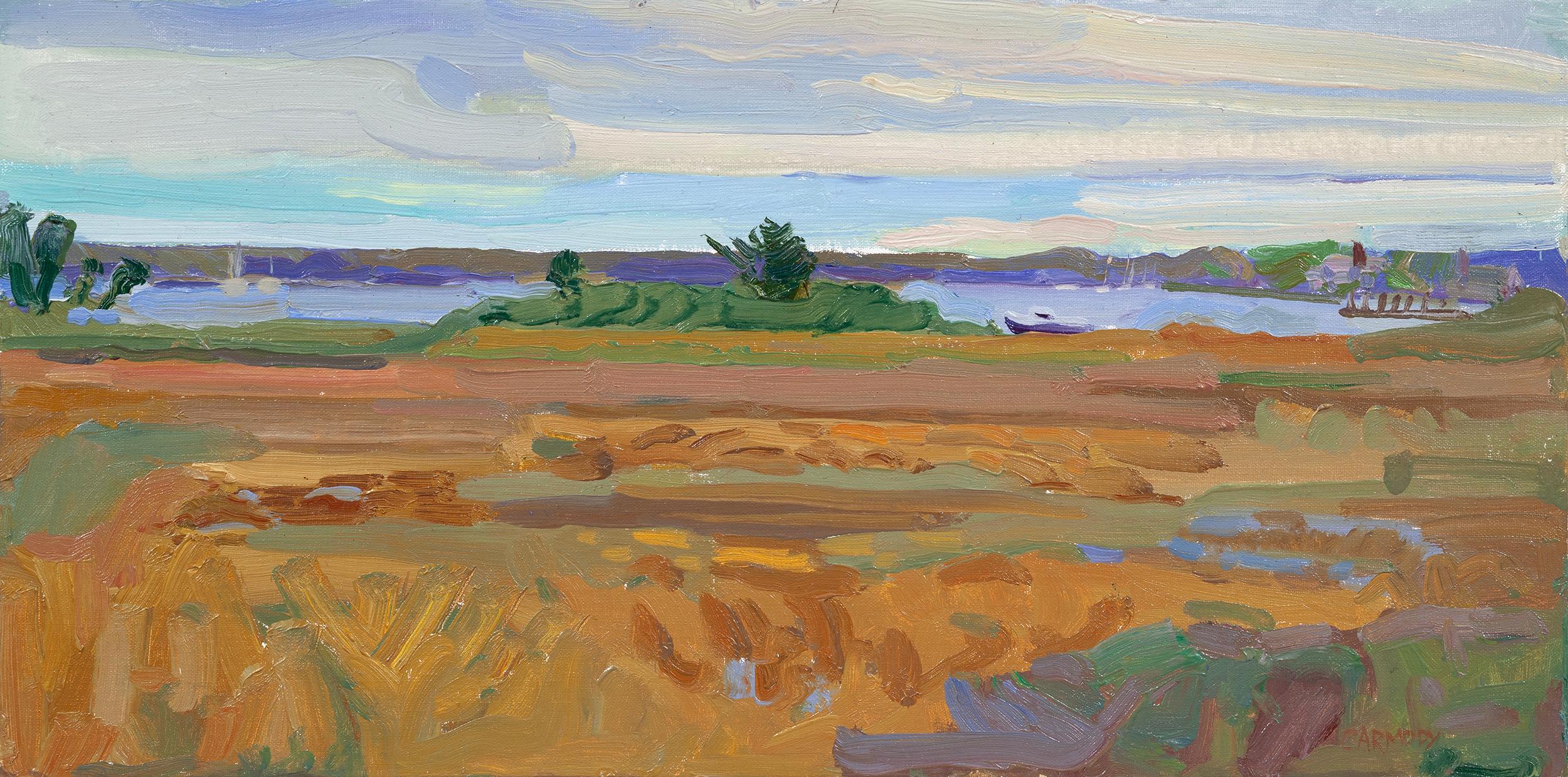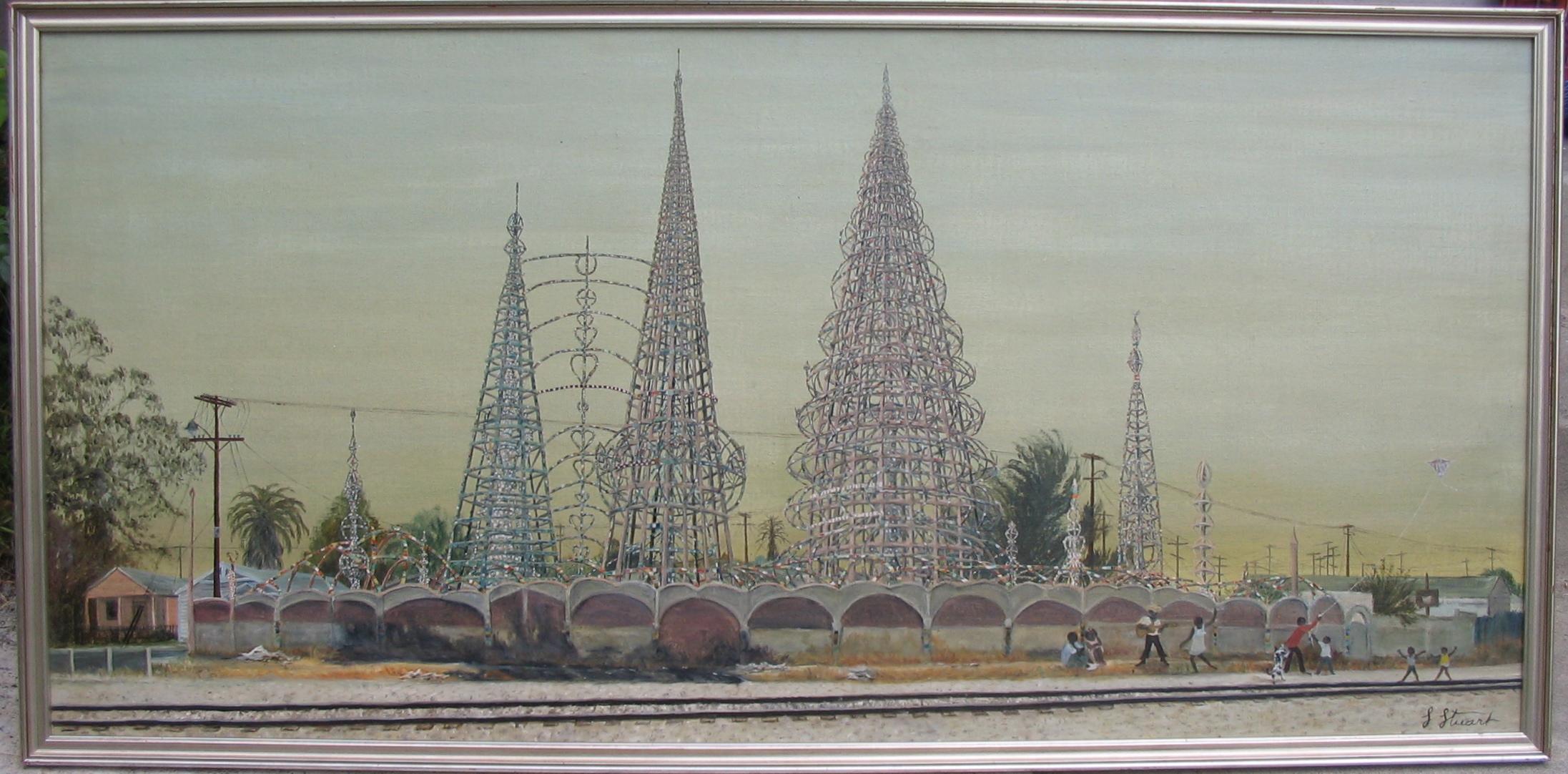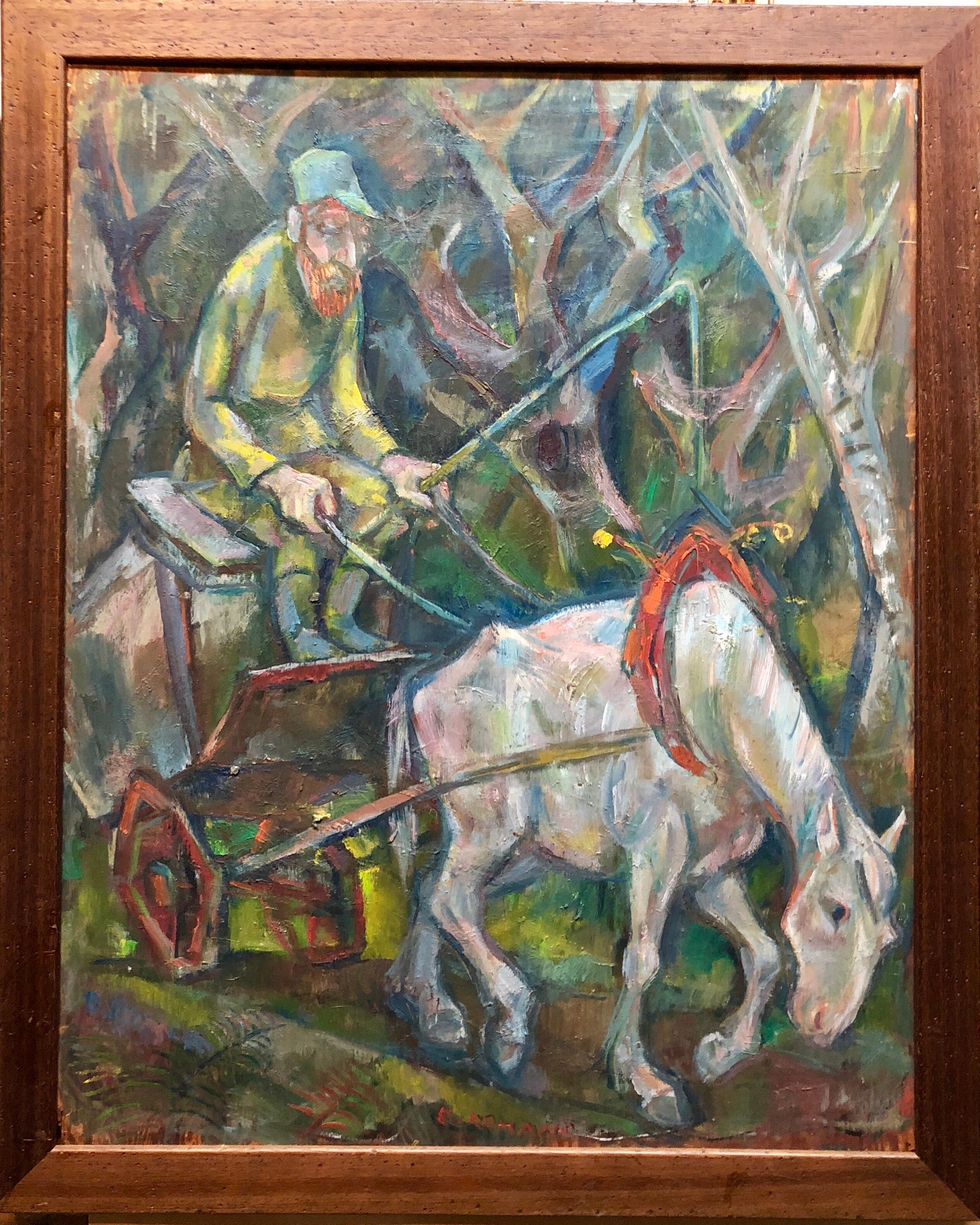Items Similar to Subway Construction
Want more images or videos?
Request additional images or videos from the seller
1 of 6
Ernest StockSubway Construction
About the Item
This painting is part of our exhibition American Coast to Coast: Artists of the 1930s
Subway Construction, c. 1928, oil on board, 19 x 15 ¾ inches, signed upper left, artist and title verso; exhibited: 1) 12th Annual Exhibition of the Society of Independent Artists, The Waldorf Astoria, New York NY, from March 9 to April 1, 1928, no. 864 (original price $250) (see Death Prevailing Theme of Artists in Weird Exhibits, The Gazette (Montreal, Quebec, Canada), March 8, 1928); 2) Boston Tercentenary Exhibition Fine Arts and Crafts Exhibition, Horticultural Hall, Boston MA, July, 1930, no. 108 (honorable mention - noted verso); 3) 38th Annual Exhibition of American Art, Cincinnati Art Museum, Cincinnati, OH, June, 1931 (see Alexander, Mary, The Week in Art Circles, The Cincinnati Enquirer, June 7, 1931); and 4) National Art Week Exhibition [Group Show], Montross Gallery, New York, New York, December, 1940 (see Devree, Howard, Brief Comment on Some Recently Opened Exhibitions in the Galleries, The New York Times, December 1, 1940)
About the Painting
Ernest Stock’s Subway Construction depicts the excavation of New York’s 8th Avenue line, which was the first completed section of the city-operated Independent Subway System (IND). The groundbreaking ceremony was in 1925, but the line did not open until 1932, placing Stock’s painting in the middle of the construction effort. The 8th Avenue line was primarily constructed using the “cut and cover” method in which the streets above the line were dug up, infrastructure was built from the surface level down, the resulting holes were filled, and the streets reconstructed. While many artists of the 1920s were fascinated with the upward thrust of New York’s exploding skyline as architects and developers sought to erect ever higher buildings, Stock turned his attention to the engineering marvels which were taking place below ground. In Subway Construction, Stock depicts workers removing the earth beneath the street and building scaffolding and other support structures to allow concrete to be poured. Light and shadow fall across the x-shaped grid pattern formed by the wooden beams and planks. It is no surprise that critics reviewing the painting commented on Stock’s use of an “interesting pattern” to form a painting that is “clever and well designed.”
About the Artist
Ernest Richard Stock was an award-winning painter, print maker, muralist, and commercial artist. He was born in Bristol, England and was educated at the prestigious Bristol Grammar School. During World War I, Stock joined the British Royal Air Flying Corps in Canada and served in France as a pilot where he was wounded. After the war, he immigrated to the United States and joined the firm of Mack, Jenny, and Tyler, where he further honed his architectural and decorative painting skills. During the 1920s, Stock often traveled back and forth between the US and Europe. He was twice married, including to the American author, Katherine Anne Porter. Starting in the mid-1920s, Stock began to exhibit his artwork professionally, including at London’s Beaux Arts Gallery, the Society of Independent Artists, the Salons of America, the Cincinnati Art Museum, the Whitney Studio and various locations in the Northeast. Critics often praised the strong design sensibility in Stock’s paintings. Stock was a commercial illustrator for a handful of published books and during World War II, he worked in the Stratford Connecticut design department of United Aircraft’s Sikorsky Aviation Division focusing on helicopters. Stock is listed in Who Was Who in American Art and other standard references.
- Creator:Ernest Stock (1896 - 1955, American)
- Dimensions:Height: 19 in (48.26 cm)Width: 15.5 in (39.37 cm)Depth: 2 in (5.08 cm)
- More Editions & Sizes:19 x 15.5Price: $7,500
- Medium:
- Movement & Style:
- Period:
- Condition:
- Gallery Location:Los Angeles, CA
- Reference Number:1stDibs: LU1859213056312
About the Seller
No Reviews Yet
Vetted Seller
These experienced sellers undergo a comprehensive evaluation by our team of in-house experts.
1stDibs seller since 2022
6 sales on 1stDibs
Typical response time: 5 hours
- ShippingRetrieving quote...Ships From: Los Angeles, CA
- Return PolicyA return for this item may be initiated within 3 days of delivery.
More From This SellerView All
- Six O'ClockLocated in Los Angeles, CASix O-Clock, c. 1942, oil on canvas, 30 x 20 inches, signed and titled several times verso of frame and stretcher (perhaps by another hand), marked “Rehn” several times on frame (for the Frank K. M. Rehn Galleries in New York City, who represented Craig at the time); Exhibited: 1) 18th Biennial Exhibition of Contemporary American Oil Paintings from March 21 to May 2, 1943 at The Corcoran Gallery of Art in Washington, D.C. #87, original price $450 (per catalog) (exhibition label verso), 2) Craig’s one-man show at the Frank K. M. Rehn Galleries, New York City, from October 26 to November 14, 1942, #10 (original price listed as $350); and 3) Exhibition of thirty paintings sponsored by the Harrisburg Art Association at the State Museum of Pennsylvania in Harrisburg in March, 1944 (concerning this exhibit, Penelope Redd of The Evening News (Harrisburg, Pennsylvania) wrote: “Other paintings that have overtones of superrealism inherent in the subjects include Tom Craig’s California nocturne, ‘Six O’Clock,’ two figures moving through the twilight . . . .” March 6, 1944, p. 13); another label verso from The Museum of Art of Toledo (Ohio): original frame: Provenance includes George Stern Gallery, Los Angeles, CA About the Painting Long before Chris Burden’s iconic installation outside of the Los Angeles County Museum of Art, Urban Light, another artist, Tom Craig, made Southern California streetlights the subject of one of his early 1940s paintings. Consisting of dozens of recycled streetlights from the 1920s and 1930s forming a classical colonnade at the museum’s entrance, Burden’s Urban Light has become a symbol of Los Angeles. For Burden, the streetlights represent what constitutes an advanced society, something “safe after dark and beautiful to behold.” It seems that Craig is playing on the same theme in Six O-Clock. Although we see two hunched figures trudging along the sidewalk at the end of a long day, the real stars of this painting are the streetlights which brighten the twilight and silhouette another iconic symbol of Los Angeles, the palm trees in the distance. Mountains in the background and the distant view of a suburban neighborhood join the streetlights and palm trees as classic subject matter for a California Scene painting, but Craig gives us a twist by depicting the scene not as a sun-drenched natural expanse. Rather, Craig uses thin layers of oil paint, mimicking the watercolor technique for which he is most famous, to show us the twinkling beauty of manmade light and the safety it affords. Although Southern California is a land of natural wonders, the interventions of humanity are already everywhere in Los Angeles and as one critic noted, the resulting painting has an air of “superrealism.” About the Artist Thomas Theodore Craig was a well-known fixture in the Southern California art scene. He was born in Upland California. Craig graduated with a degree in botany from Pomona College and studied painting at Pamona and the Chouinard Art School with Stanton MacDonald-Wright and Barse Miller among others. He became close friends with fellow artist Milford Zornes...Category
1940s American Modern Landscape Paintings
MaterialsCanvas, Oil
- Gold Mine, Central City, ColoradoBy Joseph MeertLocated in Los Angeles, CAThis painting is part of our exhibition America Coast to Coast: Artists of the 1930s Goldmine, Central City, Colorado, oil on canvas, 36 x 28 inches, c. 1936, signed lower right, ex collection of Platt Fine Art, Chicago, Illinois (label verso). About the Painting Joseph Meert’s painting, Goldmine, Central City, Colorado, depicts the short-lived resurrection of a once prominent city just outside Denver. Central City was founded in 1859 soon after John Gregory struck gold in the area. As word spread, thousands of miners converged into “Gregory’s Gulch” and its surroundings became known as the “richest square mile on earth.” Mining production quickly increased resulting in Central City to becoming Colorado’s largest city in the early 1860s. Despite some technical difficulties transitioning to lode mining and the rise of competition from Leadville, Central City remained an economic boom town through the turn of the century. But, with every boom, there is a bust. World War I marked the end of Central City’s prominence as ore production ground to a halt and by 1925, the town’s population shrank to only 400 people. The desperation of the Great Depression and a nearly 100% increase in the price of gold lured labor and capital back to Central City. Meert painted in Colorado during the mid-1930s, a time when he created his most desirable works. It is during this period of renaissance that Meert captures one of Central City's outlying dirt streets bordered by 19th century wooden houses from the town's heyday and the more recently installed electric lines leading to a distant gold mine. A lone figure trudges up the hill, a mother with a baby in her arms, putting us in mind of the rebirth of the town itself. Meert had solo exhibitions at the Colorado Springs Fine Arts Center in 1936 and the Denver Art Museum. Although it is not known whether Goldmine, Central City was included in either of these exhibitions, it seems likely. Moreover, the painting is closely related to Meert’s painting, The Old Road, which was painted in 1936 and exhibited at the Corcoran Gallery of Art in Washington, DC and at the Dallas Museum of Art. About the Artist Joseph Meert was a well-regarded painter and muralist, who initially made a name for himself in the American Scene and later as an abstract expressionist. Although initially successful, Meert struggled financially and with mental illness later in life. He was born in Brussels, Belgium, but moved with his family to Kansas City, Missouri. As a child, a chance encounter at the Union Pacific Railyard changed his life. Meert happened upon a worker repainting and stenciling a design on a railroad car. Meert later recalled that this experience introduced him to the idea of being a painter. Without support from his father, Meert obtained a working scholarship to the Kansas City Art Institute. After four years at the Kansas City Art Institute, Meert studied seven years at the Art Students League and in Europe and Los Angeles. At the Art Students League, Meert fell under the spell of Thomas Hart Benton and Stanton MacDonald-Wright. In 1931, he befriended Jackson Pollock. By 1934, Meert was part of the Public Works of Art Project when he met his wife, Margaret Mullin...Category
1930s American Modern Landscape Paintings
MaterialsOil, Canvas
- Rabbit HuntersBy Roger MedearisLocated in Los Angeles, CARabbit Hunters, egg tempera on Masonite, 12 x 9 inches, 1947, signed and dated lower left, signed, titled and dated verso “Rabbit Hunters Egg Tempera Roger Medearis 1947,” exhibited at Medearis' solo show at Kende Galleries, New York, in 1949 (Medearis’ record book, a copy of which is held by Vose Galleries in Boston, MA, indicates this is painting “No. 23” and that is was completed in 1947 and sold via Kende Galleries (at Gimbel Brothers...Category
1940s American Modern Landscape Paintings
MaterialsTempera, Board
- Factory WorkerLocated in Los Angeles, CAThis painting is part of our exhibition America Coast to Coast: Artists of the 1930s Factory Worker, c. 1936, oil on canvas, signed lower right, 18 ¼ x 36 inches; exhibited in City ...Category
1930s American Realist Figurative Paintings
MaterialsOil
- Knight’s LodgingLocated in Los Angeles, CAThis painting is part of our exhibition American Coast to Coast: Artists of the 1930s Knight’s Lodging, 1941, oil on canvas panel, signed and dated lower left, 16 x 20 inches, exhi...Category
1940s American Realist Figurative Paintings
MaterialsOil
- Industry and CommerceLocated in Los Angeles, CAThis mural study is part of our exhibition America Coast to Coast: Artists of the 1930s Industry and Commerce, 1936, tempera on panel, 16 ½ x 39 ½ inches, signed verso “John Ballator, Portland Ore.” provenance includes: J.C. Penney Company, represented by Russell Tether Fine Arts Assoc.; presented in a newer wood frame About the Painting Industry and Commerce is a prime example of WPA Era muralism. Like a Mediaeval alter, this mural study is filled with icons, but the images of saints and martyrs are replaced with symbols of America's gospel of prosperity through capitalism. Industry and Commerce has a strong narrative quality with vignettes filling the entire surface. Extraction, logistics, design, power generation, and manufacturing for printing, chemicals, automobiles and metal products are all represented. To eliminate any doubt about the mural's themes, Ballator letters a description into the bottom of the study. Ballator also presents an idealized version of industrial cooperation, as his workers, lab-coated technicians and tie-wearing managers work harmoniously toward a common goal in the tidy and neatly designed environments. Although far from the reality of most industrial spaces, Ballator's study reflects the idealized and morale boosting tone that many mural projects adopted during the Great Depression. About the Artist John R Ballator achieved success as a muralist, lithographer, and teacher during the Great Depression. Born in Oregon, he studied at the Portland Museum Art School, the University of Oregon and at Yale University where he received a Bachelor of Fine Art. In 1936, Ballator was commissioned to paint a mural panel for the new Department of Justice Building in Washington DC, an important project that spanned five years with several dozen artists contributing a total of sixty-eight designs. Ballator completed murals for the St. Johns Post Office and Franklin High School, both in Portland, Oregon. He also contributed to the 1938 murals at Nathan Hale School in New Haven, Connecticut. During the late 1930s, Ballator taught art for several years at Washburn College in Topeka, Kanas, where he completed a mural for the Menninger Arts & Craft Shop before accepting a professorship at Hollins College...Category
1930s American Realist Figurative Paintings
MaterialsTempera
You May Also Like
- Coastal Scene, 20th Century Seascape, Cleveland School ArtistBy George AdomeitLocated in Beachwood, OHGeorge Gustav Adomeit (American, 1879-1967) Coastal Scene Oil on canvas Signed lower left 19 x 23 inches 21.5 x 25.5 inches, framed A major painter of American scene subjects, Georg...Category
20th Century American Modern Figurative Paintings
MaterialsOil
- City Park, Denver, Colorado, Large Semi Abstract Colorful Oil LandscapeBy Edward MarecakLocated in Denver, COLarge format oil painting on canvas of City Park in Denver, Colorado by 20th century Denver modernist, Edward Marecak. Semi-abstract park scene with various types of trees, figures, ...Category
20th Century American Modern Landscape Paintings
MaterialsOil, Canvas
- "Looking Out" contemporary seascape with young woman in whiteBy Kelly CarmodyLocated in Sag Harbor, NY"Looking Out" is a contemporary seascape with a young woman in white admiring the view. Framed dimensions: 14 x 24 inches Kelly Carmody’s work has been widely exhibited and collect...Category
21st Century and Contemporary American Modern Figurative Paintings
MaterialsOil, Panel, Board, Linen
- "Ram Island Drive" earth toned contemporary oil painting by Kelly CarmodyBy Kelly CarmodyLocated in Sag Harbor, NY"Ram Island Drive" is an earth toned contemporary oil painting by Kelly Carmody. framed dimensions: 14 x 24 inches Kelly Carmody’s work has been widely exhibited and collected. One...Category
21st Century and Contemporary American Modern Figurative Paintings
MaterialsPanel, Linen, Oil
- WATTS TOWERBy Gloria StuartLocated in Santa Monica, CAGLORIA STUART (1910 – 2010) WATTS TOWERS, 1971 Oil on canvas, signed lower right, 24” x 50 ½”. Gloria Stuart, an Academy Award nominated actress was also a painter, illustrator and printmaker. She most recently portrayed Rose in the blockbuster film “Titanic”. She was a Santa Monica native. In 2013 The Los Angeles Museum of Art, LACMA exhibited a nearly identical painting looking from the south, the same size and frame. Last 5 photos show the example at LACMA. One shows theirs in a distant room with a major Thomas Hart Benton painting in the foreground A VERY IMPORTANT MULTI-LEVELED DOCUMENT OF LOS ANGELES AND HOLLYWOOD CULTURAL HSTORYi The following is from her obituary in the Los Angeles Times upon her death in September 2010 at the age of 100 Gloria Stuart, a 1930s Hollywood leading lady who earned an Academy Award nomination for her first significant role in nearly 60 years — as Old Rose, the centenarian survivor of the Titanic in James Cameron’s 1997 Oscar-winning film — has died. She was 100. .......She devoted much of her time to designing and printing artists’ books (handmade, letter-press printed books in limited editions, with her own artwork and writing). Her work is in the J. Paul Getty Museum in Los Angeles, the Metropolitan Museum of Art in New York City, the Victoria and Albert Museum in London and other museums. Stuart, a founding member of the Screen Actors Guild who later became an accomplished painter and fine printer, died Sunday night at her West Los Angeles home, said her daughter, writer Sylvia Thompson. Stuart had been diagnosed with lung cancer five years ago. “She also was a breast cancer survivor,” Thompson said, “but she just paid no attention to illness. She was a very strong woman and had other fish to fry.” In July the actress was honored at an “Academy Centennial Celebration With Gloria Stuart” at the Samuel Goldwyn Theater in Beverly Hills. “She was a charming and beautiful leading lady in the ‘30s, and I never understood why her career didn’t go further at that time,” film historian and critic Leonard Maltin, who interviewed Stuart on stage at the event, told The Times on Monday. As for Stuart’s high-profile comeback in “Titanic”: “She was thrilled by the attention that that performance brought her and really wanted to win that Oscar. I thought she hit just the right notes in that performance. She was wry and engaging.” As a glamorous blond actress under contract to Universal Studios and 20th Century Fox in the 1930s, Stuart appeared opposite Claude Rains in James Whale’s “The Invisible Man” and with Warner Baxter in John Ford’s “The Prisoner of Shark Island.” She also appeared with Eddie Cantor in “Roman Scandals,” with Dick Powell in Busby Berkeley’s “Gold Diggers of 1935” and with James Cagney in “Here Comes the Navy.” And she played romantic leads in two Shirley Temple movies, “Poor Little Rich Girl” and “Rebecca of Sunnybrook Farm.” But mostly she played what Stuart later dismissed as “stupid parts with nothing to do” — “girl reporter, girl detective, girl nurse” — and “it became increasingly evident to me I wasn’t going to get to be a big star like Katharine Hepburn and Loretta Young.” After making 42 feature films between 1932 and 1939, Stuart’s latest studio contract, with 20th Century Fox, was not renewed. She appeared in only four films in the 1940s and retired from the screen in 1946. By 1974, “the blond lovely of the talkies” had become an entry in one of Richard Lamparski’s “Whatever Happened to” books. Writer-director Cameron’s $200-million “Titanic” changed that. Stuart played Rose Calvert, the 100-year-old Titanic survivor who shows up after modern-day treasure hunters searching through the wreckage of the sunken ship find a charcoal drawing of her wearing a priceless blue diamond necklace. Stuart’s performance as Old Rose frames the 1997 romantic- drama that starred Leonardo DiCaprio as lower-class artist Jack Dawson...Category
1970s American Modern Landscape Paintings
MaterialsOil
- Large Modernist Oil Painting 1940s, Judaica Hasidic Shtetl Wagon Driver WPA EraBy Emanuel Glicenstein RomanoLocated in Surfside, FLGenre: Modern Subject: Landscape with figure of horse, driver and wagon Medium: Oil Surface: wood Board EMANUEL ROMANO Rome, Italy, b. 1897, d. 1984 Emanuel Glicen Romano was born in Rome, September 23, 1897. His father Henryk Glicenstein was a sculptor and was living in Rome with his wife Helena (born Hirszenberg) when Emanuel was born. His father obtained Italian citizenship and adopted the name Enrico. Emanuel was brought up in Italy, Switzerland, Germany, England and Poland. In 1926 Emanuel Glicenstein Romano and his father sailed for New York. They briefly visited Chicago. Romano's sister, Beatrice, and mother only joined them in New York years later. Romano changed his name on his arrival to America and some have erroneously speculated that this was to avoid antisemitic discrimination. In truth, as the son of a highly-regarded artist, Romano changed his name to ensure that any success or recognition he would later attain, would be the result of nothing other than his own merit as an artist, and not on account of his father's fame. In 1936 Romano was worked for the WPA Federal Art Project creating murals. ( there were many jewish artists active with in the WPA period. notably Chaim Gross, Ben Shahn, Isaac and Moses Soyer, Abraham Rattner and many others. During and immediately after World War II, Romano created a series of allegorical works depicting graphic holocaust images that were held closely by the family until after his passing. One of these works is now on permanent display in the Florida Holocaust Museum in St. Petersburg Florida. Emanuel's father died in 1942 in a car accident before they could realize their shared dream of visiting Israel. In 1944 Romano, having completed his degree at the Pennsylvania Academy of Fine Arts and the Art Institute of Chicago, began teaching at the City College of New York. Romano moved to Safed, Israel in 1953 and established an art museum in his father's memory, the Glicenstein Museum. COLLECTIONS Indianapolis Museum of Art Metropolitan Museum of Art Boston Fine Arts Museum Fogg Museum Musée Nacional de France Recently his work has been added to the Florida Holocaust Museum collection. His notable works include his holocaust themed allegorical paintings as well as portraits of Marianne Moore, his father and William Carlos Williams...Category
1930s American Modern Figurative Paintings
MaterialsOil, Board
Recently Viewed
View AllMore Ways To Browse
Stock X
Antique Construction
Subway Art
Art Concrete Construction
Subway New York
New York Subway Art
1920s Canada
New York Subway Sign
Antique American Standard
Construction Worker
Art Gazette
Society Of Cincinnati
19 C Figurative Paintings
I Beam Art
Wooden Beam
19c Figurative Painting
Original Aviation Art
Ny Subway





